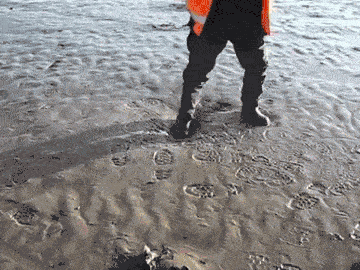You trek through a marsh, minding your own business, when all of a sudden *smooosh. Quicksand! You’re trapped, and to top your misfortune over you’re all alone. No helping friend to come to the rescue with a proverbial twig or stick to pull you out to safety. Well, farewell.

This image is often conjured when we think of quicksand — and it rightfully sounds scary.
But in reality, quicksand is far from being this treacherous or dangerous.
Quicksand rarely completely engulfs people and animals. Its density is twice that of the human body, which means that it’s impossible for you to sink — unless you struggle. We’ll get to that in a minute.
It’s almost impossible to be killed by quicksand, no matter what Hollywood might tell you.

That’s because quicksand is made of sand or very grainy soil that’s saturated with water. Most often than not, clay and salt can be found in the composition of quicksand. In this semi-liquid state, the sand shifts fast, hence “quicksand”, and stops supporting your weight.
What is quicksand and what’s it made of?
Quicksand is a shear-thinning non-Newtonian fluid that looks like a gel when undisturbed but quickly drops in viscosity once an object rests its mass. Quicksand is a mixture of sand or silt and water, creating a treacherous concoction that can trap the unwary traveler.
Quicksand can appear virtually anywhere in the world if an area of loose sand is saturated by water and becomes agitated. One of the following situations can lead to the formation of quicksand:
- Underground water. Most often, this is the likeliest source of quicksand formation. If an underground reservoir can flow upward through loose sand, the sand grains lose friction and the entire soil becomes a suspension. The grains literally float on top of the water.
- Vibrations. Earthquakes or some other high-vibration source can increase the pressure of shallow groundwater through shaking, thus liquefying the soil. This is why sometimes you hear of buildings sinking even by more than a foot following an earthquake.
While quicksands can be found all over the globe, there are naturally some areas that are more prone to host them like riverbanks, beaches, lake shorelines, near underground springs or marshes.
Daniel Bonn of the University of Amsterdam in the Netherlands and the École Normale Supérieure in Paris investigated what makes quicksand so puzzling: easy to get in, hard to pull out.
His research shows that quicksand is highly sensitive to the forces applied to it. Just a 1% change in stress caused the viscosity of the mixture to drop by a factor of nearly a million, turning the quicksand mixture from a solid to gooey liquid.
Once the quicksand stiffens, it becomes extremely difficult to retrieve an object that’s stuck inside. For instance, if your foot is stuck in quicksand, pulling it out at a rate of 1 centimeter per second would require the same force needed to lift a medium-sized car, Bonn and colleagues found.
There was some good news though. Their research puts to rest an old myth about quicksands. “Although you are trapped, you cannot drown,” says Bonn who placed various objects in a quicksand mixture but these never completely submerged.

But doesn’t mean that quicksand isn’t dangerous. If you’re all alone and don’t know how to get out, you may be in for a lot of trouble. You can be exposed to the sun and cold, and may even suffer from starvation or dehydration.
How to escape quicksand
Because the water seeps in from the bottom, the top layer of quicksand is often dry. To unsuspecting travelers, this all looks like normal sand — that’s until you step on it.
You shouldn’t panic if you fall into quicksand. It’s rarely more than a few feet deep and the worst that can happen, in most situations, is you lose a shoe!
If you ever find yourself trapped in quicksand remember:
- you won’t die. I promise.
- the harder you struggle, the more you’ll get trapped. Try to relax and never flail your arms and legs. If you do so, you will only succeed in forcing yourself farther down into the liquid sandpit.
- the human body has a density of 62.4 pounds per cubic foot (1 g/cm3) and is able to float on water when the body’s surface area is spread out. Quicksand typically has a density of 125 pounds per cubic foot (2 g/cm3). This means you can float on quicksand more easily than on water.
The first thing you should do is drop your bags or gear. The less weight you pull, the better. Also, try pulling off your shoes as these create friction when you try to pull out of the quicksand. If it’s impossible to take off your shoes, it’s still ok. But if you know you’re trekking through quicksand country, it’s actually better if you walk barefoot. Use a walking stick to prod the soil in front of your path.
If you get one foot stuck, try to move backward. It takes a minute for the sand to become liquefied, so you still have a bit of time left before you get stuck.
When you do get stuck, it’s time to get messy. Imagine you’re in a big pool instead of a quicksand marsh, what do you do to get out? Why, you swim of course. Position yourself horizontally and lean on your back. This will distribute the pressure of your body’s weight more evenly.
You’ll start floating. You’re basically going to backstroke yourself out from there. Kick your legs slowly to loosen the sand around them and then try to gently bring them up towards the surface. With your hands slowly paddle with short strokes on the surface, being careful not to submerge the hands too much. Once you’ve paddled to the edge of more solid ground, pull yourself out.
What you should really be afraid of
Quicksand isn’t exactly harmless, but it’s not life-threatening either. Aside from getting yourself dirty and losing your shoes or backpack, quicksand is nondeserving of its frightening reputation. This distinction should belong to its much scarier cousin, dry quicksand.
Dry quicksand forms when grains of sand form a very loose structure that can barely hold its own weight, let alone yours. Scientists make it by blowing air through the sand. If an object of meaningful density is dropped on the sand, it will instantly sink and the whole sandy structure will collapse like a house of cards.
The show doesn’t stop here. Once this process is initiated, the energy from the collapse triggers a jet of sand whirling upwards.

Aluminum ball takes less than a second (700ms) to become completely submerged!
If anyone, man or animal, were to fall into dry quicksand then they’d get buried fast. Fortunately, no dry quicksand has ever been seen in the wild — only in the lab.
But scientists don’t overrule the possibility of its existence in nature. It could form when desert winds blow to form a patch of dry quicksand on the down-wind side of a dune. In fact, during the Apollo mission days, NASA scientists were so concerned about loose layers of debris, soil, and dust on the moon’s surface that they installed large plates to the ends of the lander’s legs.
Remember that knowledge and preparedness are essential when venturing into nature’s unpredictable landscapes. Quicksand, though alluring and mysterious, can be understood and easily escaped with a calm atitude and the right techniques.


